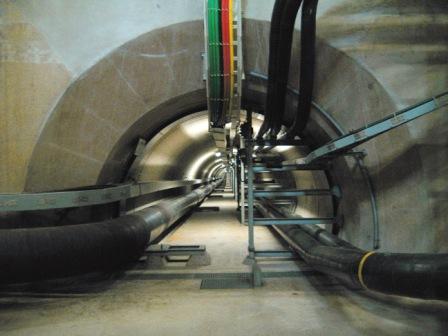NATO Pipeline System
NATO has a pipeline system designed to ensure that its requirements for petroleum products and their distribution can be met at all times.

- The NATO Pipeline System (NPS) was set up during the Cold War to supply NATO forces with fuel and it continues to satisfy fuel requirements with the flexibility that today's security environment requires.
- The NPS consists of ten distinct storage and distribution systems for fuels and lubricants.
- In total, it is approximately 10,000 kilometres long, runs through 12 NATO countries and has a storage capacity of 4.1 million cubic metres.
- The NPS links together storage depots, military air bases, civil airports, pumping stations, truck and rail loading stations, refineries and entry/discharge points.
- Bulk distribution is carried out using facilities from the common-funded NATO Security Investment Programme.
- The networks are controlled by national organisations, with the exception of the Central Europe Pipeline System (CEPS), which is a multinational system managed by the CEPS Programme Office under the aegis of the NATO Support and Procurement Agency.
Structure and geographical reach
The NPS is overseen by the Petroleum Committee, which is the senior advisory body in NATO on consumer logistics and, more specifically, on petroleum issues. The Petroleum Committee reports to the Logistics Committee on all matters of concern to NATO in connection with military fuels, lubricants, associated products and equipment, the NPS and other petroleum installations.
The NPS consists of eight national pipeline systems and two multinational systems:
- The national pipeline systems
- the Greek Pipeline System (GRPS);
- the Icelandic Pipeline System (ICPS);
- the Northern Italy Pipeline System (NIPS);
- the Norwegian Pipeline System (NOPS);
- the Portuguese Pipeline System (POPS);
- the Turkish Pipeline System (TUPS), which comprises two separate pipeline systems known as the Western Turkey Pipeline System and the Eastern Turkey Pipeline System.
- The two multinational pipeline systems are:
- the North European Pipeline System (NEPS) located in Denmark and Germany;
- the Central Europe Pipeline System (CEPS) covering Belgium, France, Germany, Luxembourg and the Netherlands. This is the largest system.
In addition to the national and multinational systems, there are also fuel systems in Bulgaria, the Czech Republic, Estonia, Hungary, Latvia, Lithuania, Poland, Romania, Slovakia, Slovenia and Spain.
The optimum use of NATO petroleum facilities in peacetime is essential for the proper maintenance of the NPS and the necessary training of its staff. NATO members use the facilities to the fullest extent practicable for military purposes and use spare capacity for commercial traffic providing that does not detract from the primacy of the military use of the system.
Historical evolution
The NATO Pipeline System was set up during the Cold War to supply Alliance forces with fuel.
In order to support the new missions of the Alliance, the emphasis has shifted away from static pipeline infrastructure to the rapidly deployable support of NATO’s expeditionary activities. To this end, NATO has developed a modular concept whereby all fuel requirements can be satisfied through a combination of 16 discrete but compatible modules which can receive, store and distribute fuel in any theatre of operation. The concept also enables both NATO and partner countries to combine their capabilities to provide a multinational solution to meet all fuel requirements.
Even with the emphasis on expeditionary operations, the existing static pipeline infrastructure remains an important asset for the Alliance. Since the end of the Cold War, the NPS has been used to support out-of-area operations from the European theatre or using NATO airfields as an intermediate hub. The sudden increase in fuel demand mainly for airlift and air-to-air refuelling can only be met by the NPS, which remains the most cost-effective, secure and environmentally safe method of storing and distributing fuel to Alliance forces.
